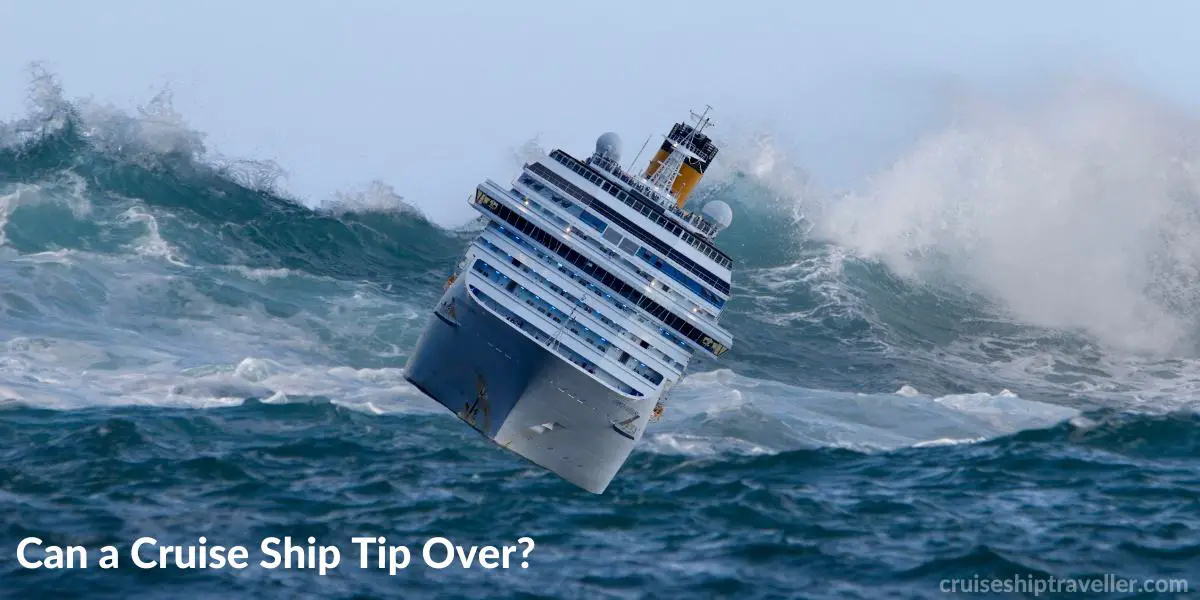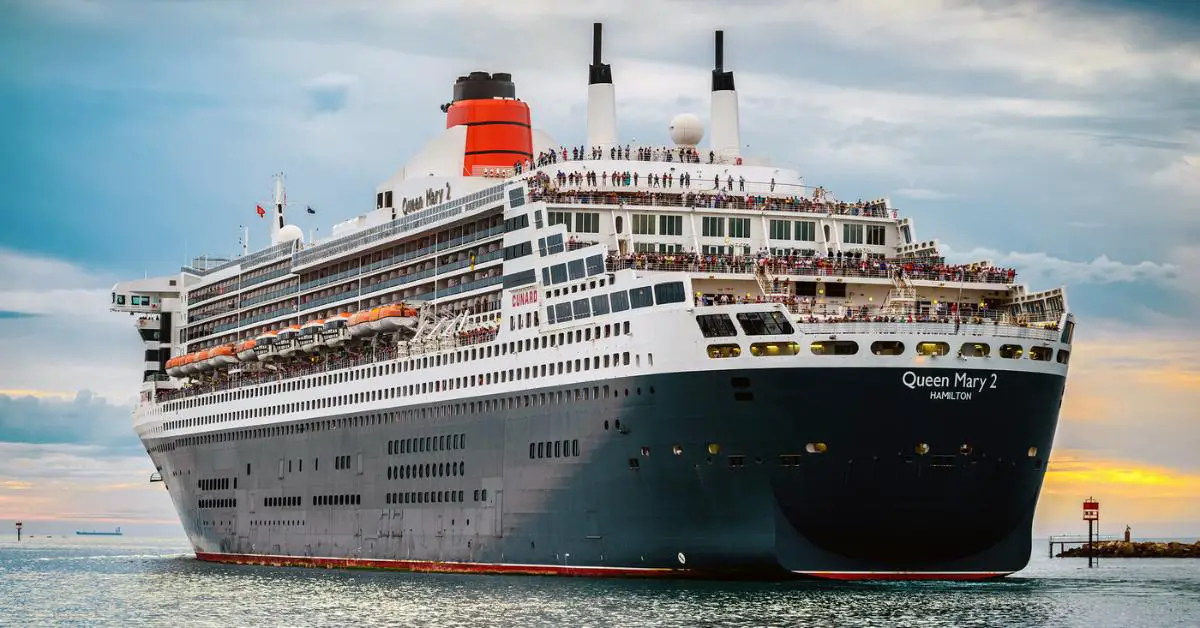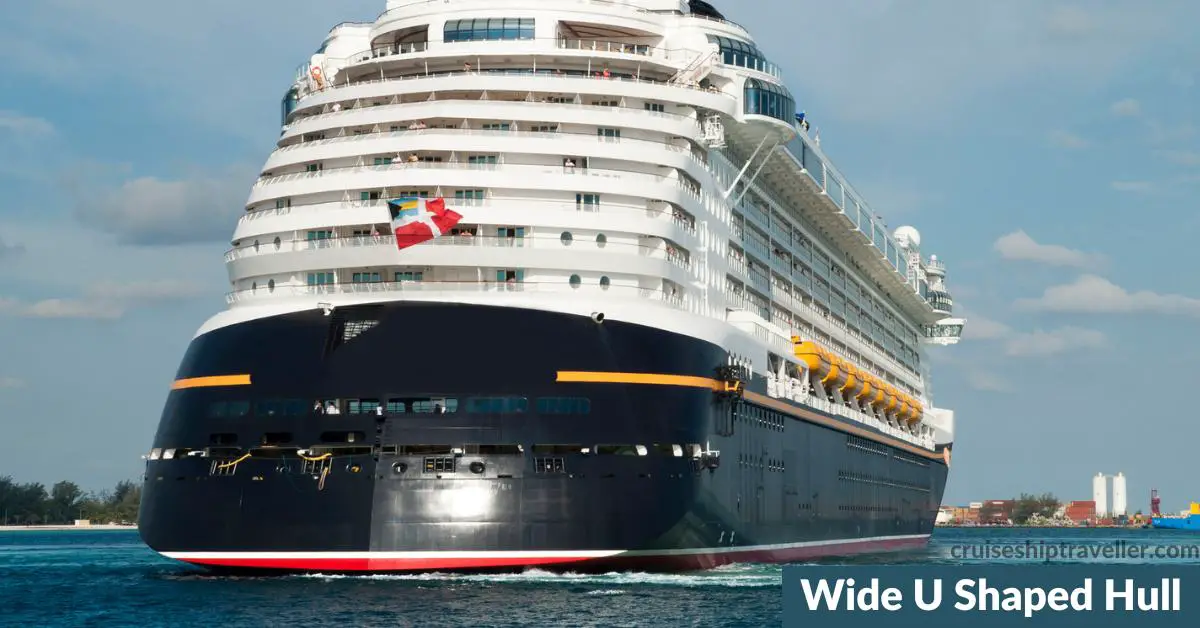Modern-day cruise ships are enormous, with many having 15 decks or more; some are like high-rise buildings on the sea.
So it’s not surprising that some people wonder how they do not tip over, especially in some of the rough seas they inevitably encounter.
So let’s look at the critical design elements that keep a cruise ship upright and stop it from tipping over.

While it is not impossible, It is extremely unlikely for a cruise ship to tip over even if it encounters some of the roughest seas on earth.
Cruise ships of all sizes are designed to withstand rough sea conditions and large waves, which, while they may significantly roll the ship from side to side, will not typically be anywhere near strong enough to cause the ship to keel over.
A rogue wave might be the most significant potential threat to rolling a cruise ship over. However, the chances of these occurring are very remote, let alone being in the vicinity of a cruise ship, although rogue waves have hit cruise ships before, and in each recorded instance, they survived.

In addition to all the design elements that keep a cruise ship upright and stable, there are also actions the cruise captain and accompanying crew can take to offset any adverse weather and sea conditions.
For example, the captain can adjust the weight distribution within the ship to offset the effects of the sea conditions.
How Do Cruise Ships Not Tip Over?
Cruise ships can roll to nearly 60 degrees before it’s likely to tip over.
Cruise ships are built to withstand the roughest seas and large waves up to 50 feet high, which would be way higher than the average expected in a stormy sea. However, some rogue waves have been known to exceed 50ft.
By design cruise, ships go under numerous tests under small-scale model conditions. They are tested for the most extreme weather events they might encounter, including hurricanes and rough seas, and even much rarer rogue wave scenarios.

In the days of the Titanic cruise ship (actually an ocean liner), ships were smaller and sleeker in design. In those days, they were built for speed in the roughest of seas for crossing the likes of the Atlantic with passengers and cargo.
Whereas modern-day cruise ships are built purely for leisurely purposes. The more decks and the higher the cruise ships can be created, the more paying passengers and facilities they can fit on board and ultimately make more money.
But the higher they are built, the more likely they look to tip over, especially when you know they are top-heavy with swimming pools, some with a couple of hundred tonnes of water.
Tipping seems even more likely when you realize only a relatively small portion of the cruise ship is underwater, typically only about 10% of its total height.
Not only do cruise ships have to carry the huge weight of the ship, but they also carry the weight of all the fittings, furnishings, facilities, passengers, and all their luggage.
Several design factors come into play in keeping cruise ships upright and in the event of rolling, ensuring they roll.
We cover each of them below.
Low Center of Gravity
Having a low center of gravity makes its much more difficult for an object to be tipped over.
Although modern-day cruise ships look very top-heavy, most of the weight is distributed in the bottom of the ship and lower decks..
The hull is surrounded by a hull made of dense steel which holds the heavy mechanical machinery of the ship, including the engine room, air condition units, generators, as well food storage, luggage, and much more.
The upper half of the ship is much less dense, and much of the superstructure of the ship is made of aluminum which is lighter than the steel needed below for a strong hull.
One exception on the higher decks is the significant weight of water in the swimming pools, most often on the higher decks of a cruise ship, which raises the center of gravity higher up the ship. These can however be emptied if required.
The center of gravity of a cruise ship can be controlled by increasing or decreasing the weight of the ship.
The Cruise captain and navigation crew have several options for adjusting the weight of the ship, including:
- Ballast tank water levels
- Fuel levels
- Onboard swimming pool levels
Center of Buoyancy
We have covered the importance of buoyancy in how a cruise ships float.
When it comes to whether a cruise ship can tip over its the center of buoyancy that is more relevant.
The center of buoyancy is the center of the cruise ship underwater.
When a ship is tilted to one side due to an external force (wind or waves) more of the ship goes underwater which in turn moves the center of buoyancy towards the center of the larger area of the ship underwater.
With the center of gravity pulling down from its original position and the center of buoyancy pulling up from its changed position with more of the ship beneath the water creates a force which pushes the ship back to its upright position until the center of gravity and center of buoyancy are back in line.
The center of buoyancy is very illustrated in the video below:
The above video also explains how an internal force can cause a ship to tip to one side, although in reality on a cruise ship there wouldn’t be enough weight onboard to make much a difference, even if everyone on board moved over to one side.
Even if they did the ship would automatically adjust the weight on board through other means such as ballast tanks.
Wide U-Shaped Hull

Cruise ships have large rounded U-shaped hulls, which make the ship more stable and reduce any rocking motions it may experience in rough seas compared to V-shaped ships.
The width of some cruise ships is nearly as wide as they are tall above the waterline. This also keeps the ship stable when being hit by strong winds from the side.
A Wide U-hull also helps reduce any rocking motions the passengers may feel and contributes to a more pleasant sailing experience.
The slight disadvantage is that cruise ships are slower-moving than faster-moving V-shaped ships.
Ballast Tanks
Ballast tanks are large tanks within the hull of the cruise ship. They can be filled with water to increase the vessel’s weight and lower its center of gravity. The larger the cruise ship, the more ballast tanks they are likely to have.
Alternatively, if required, the water can be released and replaced with air to lighten the ship’s weight.
Ballast tanks are what submarines use to sink in the water. If they release the water, the tanks fill with air, and the submarine rises.
Bilge Keels
Bilge keels look like two fin-like structures running along the center of the cruise ship’s hull for about two-thirds of its length.
The purpose of bilge keels is to dampen the ship’s tendency to roll by adding resistance to the water as the ship rolls.
Although they look relatively small on a huge cruise ship, the forces on them cause a significant movement to oppose the rolling.
What If a Cruise Ship is Damaged?
Although accidents are rare, they can happen. For this reason, many cruise ships have double hulls, which is, as it sounds, one hull built within another.
Therefore if the outer hull is damaged, the inner hull should maintain a water-tight seal.
In the instance of significant damage, cruise ships have bulkheads that can assist in keeping the ship afloat.
A bulkhead is a watertight division built with the cruise ship’s structure. These can limit the spread of water flooding from one division to another on either side, thereby containing any flooding from hull damage to a limited area and reducing the weight the ship can take on.
Cruise Ship Nearly Tipping Over
Video footage of cruise ships nearly tipping over is rare because the event itself is rare.
However, on 26th January 2005, footage was captured of a mid-sized cruise ship, the MV Explorer, tipping heavily from side to side.
This was due to a freak occurrence of the ship being hit by a 50ft rogue wave whole being caught up in a combination of three storms!
The mid-sized cruise ship, which could carry over 800 passengers, was carrying approximately 700 students.
As the rogue wave hit, it smashed windows on the bridge, which shorted out the ship’s navigational systems, and two of the main engines died.
The cruise ship had lost propulsion and was at the mercy of the waves, and was mercily rolling back and forth.
The cruise ship tipping ship was caught on camera, as shown in the video below.
However even in these extraordinary circumstances did not tip over and ship survived. It has since been renamed MV Glory Sea.
The event, including some live footage from inside the ship, was also captured and featured in a mini-documentary by the Weather Channel, which can be seen on Youtube here if you’re interested.
How Do Cruise Ships Stay Upright?

A cruise ship is designed with a wide U-shaped hull acting as a stable base.
In the event of rough seas or high winds causing the ship to tilt from side to side past its centerline is known as rolling. It’s this movement that can lead to the feeling of seasickness.
Cruise ships can use ballast tanks in the hull to combat this rolling and stabilize fins beneath the water.
The ballast tanks are controlled automatically by anti-heeling systems, which have sensors that send signals of the ship’s angle in retaliation to its upright position and transfer water from the heeled side to the other side of the cruise ship returning the ship to its upright position.
All these features combined make any motion on a cruise ship barely noticeable most of the time.
Let alone be bad enough for the ship to tip noticeable to one side or the other.
Frequently Asked Questions
Has Crew Ship Tipped Over?
There have been cases of cruise ships tipping over and even sinking. However, these are due to accidents such as the most recent and well-known modern example of the Costa Concordia, which hit a reef before tipping over.
The impact of the reef severely damaged the ship letting large amounts of water onboard.
Can A Whale Tip Over A Cruise Ship?
A whale could not tip over a cruise ship. Although even the largest of blue whales can weigh up to 200 tonnes, the largest cruise ships can weigh up to 220,000 or more.
Some cruise ships would carry ten times more freshwater or fuel than the weight of even the largest whales.
Any impact would be more of a knock. If a smaller or midsize cruise were knocked off its center of buoyancy, it would immediately right itself, roll back to its upright position.
What Would Happen If All The Passengers Went To One Side Of The Ship?
The bulk of the weight of a cruise ship is in the lower decks. This can amount to thousands of tonnes if you include all the engines and machinery combined with water and fuel tanks alone on large cruise ships totaling thousands of tonnes.
So if everybody onboard went to one side of the ship, it would still not amount to enough weight to noticeably ship the ship’s center of gravity.
Even if the impact did affect the angle of the ship, the affected ship’s sensors would detect the change and adjust the ballast tanks accordingly.
So if this is ever a fear of yours, there’s nothing to worry about.
Conclusion
If you have any fear of a cruise ship tipping over while at sea, hopefully, this post has put your mind at rest.
Cruise ships are designed to withstand the roughest of sea conditions. Although modern mega cruise ships look tall and top heavy, they have huge amounts of weight in the lower decks, making them almost impossible to keel over when facing even the roughest of seas.


